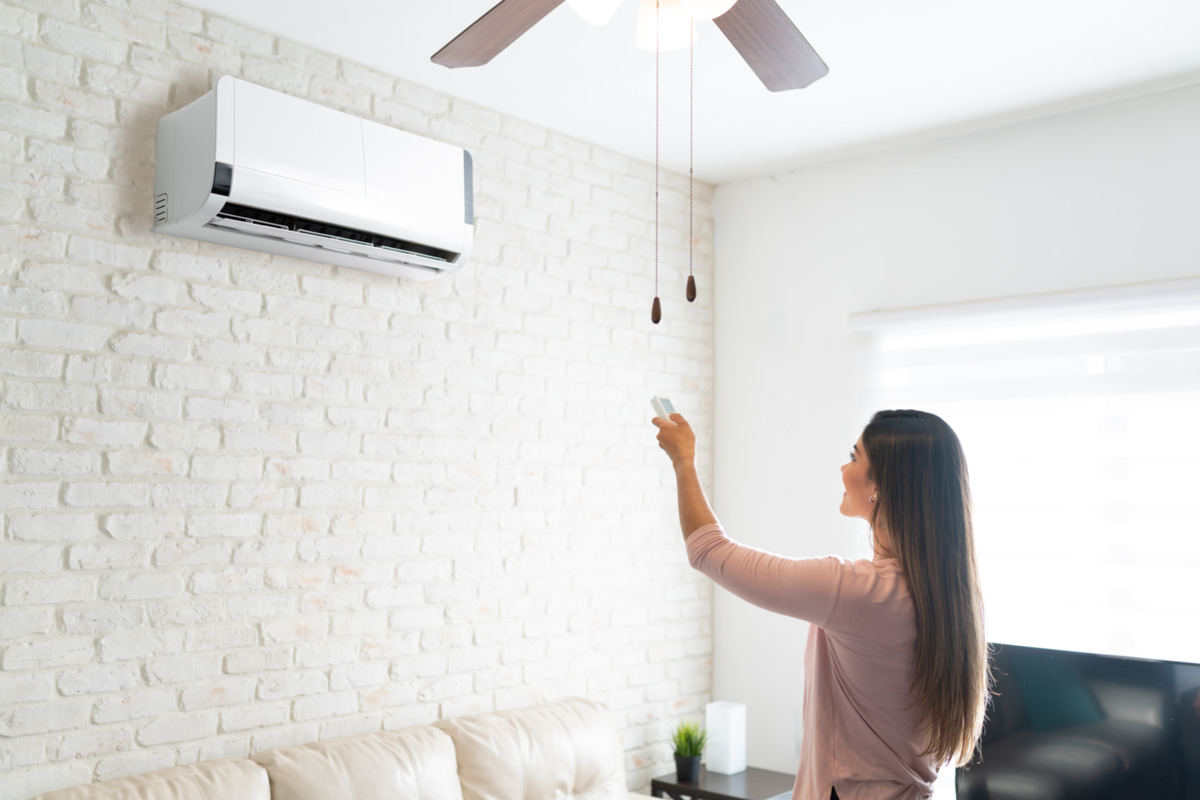Most homeowners have a standard A/C unit that changes the temperature of their house whenever they set the thermostat. Although this form of temperature control can be convenient, it may not always be the most efficient way to heat or cool a home. This is where mini-split systems come in.
A mini-split system, also known as a ductless air-conditioning system, is an alternative method for cooling your home. Unlike traditional A/C units, these systems do not require ductwork to deliver cooled air throughout your house. Below, we’ve detailed why a mini split can be more efficient than whole-house A/C.
Personalized Temperature Control
With a traditional A/C unit, the thermostat is usually located in a central area of the house, and once you set the temperature, it’ll impact the whole home. While this is fine if you live alone, if you have a family or housemates, everyone may have a slightly different idea of what’s comfortable. This can lead to disagreements and sometimes wasted energy.
When you install mini-splits throughout the house, you zone off areas and can personalize the temperatures. For example, you may want your bedroom to remain around 68 degrees Fahrenheit, while your child may prefer their room to be at 72 degrees. You can adjust the temperature in each zone independently, ensuring everyone is comfortable without wasting energy.
No Need for Ductwork
Central A/C systems rely on ductwork to distribute cooled air throughout the home. The duct system connects to vents, which blow cool air from your A/C unit into each room. However, this ductwork can become dirty and clogged over time, reducing the efficiency of your system. Likewise, if the HVAC tech doesn’t properly install the ducts or system, air may escape through cracks and holes in the ducts, leading to energy loss.
Mini splits sidestep this issue entirely by operating without ducts and instead rely on small tubes that run from the outdoor unit to each indoor one. This means there is much less opportunity for air to escape, leading to a more efficient cooling process. Plus, with no ducts to clean or maintain, there’s less maintenance and less potential for issues in the future.
Flexible Installation Options
The adaptability of mini-split systems allows homeowners to install them in areas central A/C often cannot reach, such as garages, attics, or additions. Installation is also uncomplicated compared to central A/C systems. Without ductwork, mini-splits don’t require major labor costs associated with installing and maintaining ducts. Professionals simply drill a small hole in the wall to connect the indoor and outdoor units, then mount the indoor unit on a wall or ceiling.
Quiet Operation
Although modern A/C units are far quieter than their predecessors, an individual unit is significantly quieter still. The reason is that mini-splits use small fans in each indoor unit, which means you’ll hardly hear them working to cool your room(s). Since mini-splits are quieter, they’re ideal for bedrooms, offices, and other peaceful environments.
Lower Utility Bills

Mini-splits can be more energy-efficient than traditional HVAC systems since they only cool needed rooms. If you’re not using a specific room, you don’t have to waste energy heating or cooling it; this targeted approach drastically reduces energy consumption.
Moreover, energy efficiency contributes directly to lower monthly utility costs. Since mini-splits use less electricity than whole-house systems, homeowners can expect noticeable savings on their energy bills. After all, central systems consume a lot of energy to cool every room in the house, even unoccupied spaces.
Simpler and Cost-Effective Maintenance
Since mini-split systems lack complex ductwork, they require less maintenance than central A/C units. Mini split maintenance primarily involves cleaning or replacing air filters for adequate airflow.
Additionally, due to their modular design, mini-splits often have lower repair costs. Unlike central systems, where a failure often disrupts the entire system, mini-splits isolate issues to a single air handler, limiting repair complexity and expenses.
Tips for Choosing the Right Mini-Split System
Understanding why a mini-split is more efficient than whole-house A/C can help you decide whether buying one is yourbest option. Although traditional HVAC systems have advantages, mini splits offer a targeted approach to heating and cooling, which can help reduce your energy bill and increase home comfort even more.
When shopping for a mini-split system, consider the following:
Evaluate Your Space
The first step in selecting a mini-split system is assessing your space’s specific needs. Consider the room’s size, insulation quality, and overall layout. These factors will determine how much heating or cooling power the area requires.
For accurate calculations, measure the square footage of your room and determine the British thermal units (BTUs) needed for efficient operation. One way to do this is to measure the square footage of the room and multiply that number by 20 to 25 for the BTUs needed. Noting the number of windows and the amount of sun exposure in the room is also vital; the intense Florida sun can quickly heat your home as it streams through the windows.
Note Energy Rating
All appliances have an energy rating, and mini-split systems are no exception. The higher the rating, the more efficient the unit is, which can translate to lower monthly energy bills. Look for Energy Star-certified models that have been independently tested and proven to meet or exceed efficiency standards.
Understand the Types of Mini-Split Systems
Mini-split systems are available in two primary types: single-zone and multi-zone. Single-zone systems control the temperature in one specific area. They’re ideal for heating or cooling a single room or an enclosed space.
Alternatively, multi-zone systems allow you to regulate temperatures in multiple rooms or zones independently. While multi-zone systems provide greater flexibility, they often require a higher upfront investment.
Maintain Your Mini-Split System
Regular maintenance ensures that your mini-split system operates efficiently and lasts for years. Clean air filters every one to two months to maintain proper airflow and remove dust and debris. As you care for the indoor unit, you should also check the outdoor one to confirm it’s free of obstructions and dirt.
Moreover, watch for signs indicating the need for professional maintenance, such as reduced airflow, unusual noises, or inconsistent cooling. Addressing these issues early prevents costly repairs and helps your system maintain peak performance.
Hire Professionals for Installation

Proper installation is critical when setting up a mini-split system. Hiring a licensed HVAC technician ensures proper unit installation, minimizing the risk of future malfunctions. Technicians handle tasks like refrigerant line installation and system calibration, which require specialized skills and tools. Professional installation also protects your warranty.
Style Crest offers mini split installationand maintenance to homeowners in Melbourne, FL, and the surrounding area. With over 50 years of business experience, you can count on our ductless A/C installers to provide top-quality service. Contact us today to schedule your mini split services so you can keep your home at a comfortable temperature.


